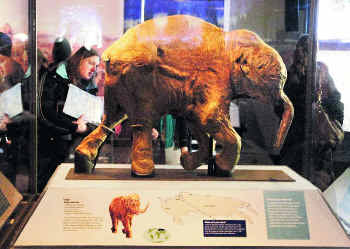
Scientists say the mammoth calf named Lyuba is the best preserved and most complete mammoth specimen known.
She was found in 2007 by a reindeer herder in northern Siberia's remote Yamal-Nenets autonomous region and named for his wife.
"Her preservation, her really lifelike qualities allow you to form a better impression of what the past was really like," said Dan Fisher, a University of Michigan paleontologist and the museum's exhibit curator. "It becomes more immediate. It's real."
In the exhibit, visitors can see the folds and creases in Lyuba's (pronounced lee-OO-bah) skin, the bottom of her foot and small patches of hair on her ear and leg. At 45 inches long, Lyuba weighs about 92 pounds and if fully grown could have measured 8 feet tall at her shoulder and weighed between three and four tons, Fisher said.
Scientific analysis
Lyuba has been a boon for scientists, who have done MRIs, CT scans and DNA testing, among other analysis, on the baby mammoth.
"The things you can learn from a fleshy specimen like this that you can't learn from studying a skeleton," said Tom Skwerski, the museum's project manager for the exhibit. "It's as if all of a sudden you've been given this great gift to be able to reaffirm a lot of your theories."
Scientists have analyzed Lyuba's stomach contents, finding her mother's milk. They say she was 1 month old when she died and was in excellent condition.
Scientists first analyzed Lyuba's baby tusks and chewing teeth, looking for details about diet, environment and health.
"The important thing about Lyuba, though, is that in a sense she gave us the answers to many of the questions we would ask through those analyses," Fisher said. "Because there's her whole body preserved in its entirety."
Experts say the baby mammoth remained well-preserved because she was frozen in permafrost for thousands of years. Fisher also said her body was colonized by naturally occurring bacteria that produced lactic acid, which kept her body pickled.
Lyuba's body was immersed in preservative solutions for her Chicago display, scientists said.
"To get Lyuba for our exhibition is like getting the Mona Lisa for your exhibition on Italian art," Skwerski said.
Russia is home
The baby mammoth's home institution is the Shemanovskiy Museum and Exhibition Center in Salekhard, Russia. She is the centerpiece of a larger multimedia exhibition at the Field called "Mammoths and Mastodons: Titans of the Ice Age" through Sept. 6 (www.field museum.org).
The exhibit is to travel to other North American cities, including Jersey City, N.J.; Anchorage, Alaska; St. Louis; San Diego; Denver; and Boston.



Reader Comments
to our Newsletter